1994 Northridge earthquake

1994 Northridge earthquake

| UTC time | 1994-01-17 12:30:55 |
|---|---|
| ISC event | 189275 [58] |
| USGS-ANSS | ComCat [59] |
| Local date | January 17, 1994 (1994-01-17) |
| Local time | 4:30:55 a.m. PST[1] |
| Duration | 10–20 seconds[2] |
| Magnitude | 6.7 Mw[3] |
| Depth | 11.31 mi (18.20 km) |
| Epicenter | 34°12′47″N 118°32′13″W [60] |
| Type | Blind thrust |
| Areas affected | Greater Los Angeles Area Southern California United States |
| Total damage | $13–$44 billion[4] (equivalent to $22–74 billion today) |
| Max. intensity | IX (Violent)[1] |
| Peak acceleration | 1.82g horizontal[5] |
| Casualties | 57 killed8,700 injured |
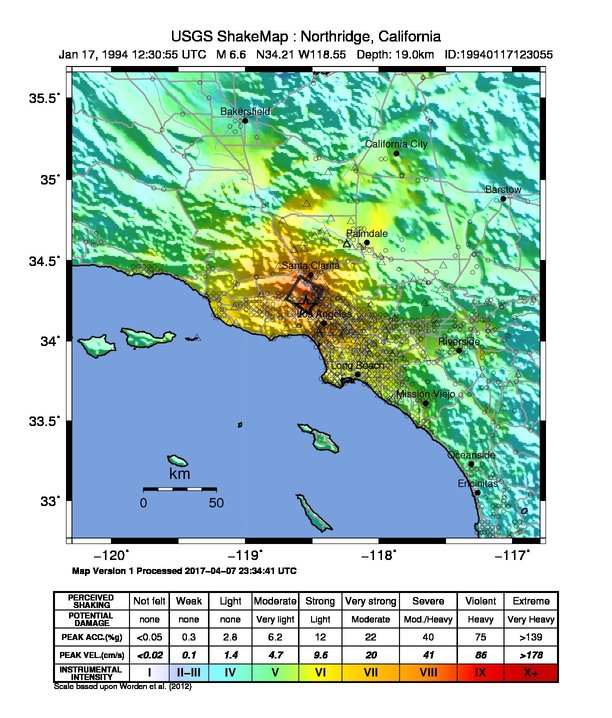
Map of perceived intensity of shaking

Magnitude of 1994 Northridge earthquake
The 1994 Northridge earthquake was a magnitude of 6.7 (Mw),[6] blind thrust earthquake that occurred on January 17, 1994, at 4:30:55 a.m. PST in the San Fernando Valley region of the County of Los Angeles. Its epicenter was in Reseda, a neighborhood in the north-central area of the San Fernando Valley. The quake had a duration of approximately 10–20 seconds, and its peak ground acceleration of 1.8g (16.7 m/s2)[7] was the highest ever instrumentally recorded in an urban area in North America.[8] Strong ground motion was felt as far away as Las Vegas, Nevada, about 220 miles (360 km) from the epicenter. The peak ground velocity at the Rinaldi Receiving Station was 183 cm/s[9] (4.09 mph or 6.59 km/h), the fastest ever recorded.
Two 6.0 Mw aftershocks followed, the first about one minute after the initial event and the second approximately 11 hours later, the strongest of several thousand aftershocks in all.[10] The death toll was 57, with more than 8,700 injured. In addition, property damage was estimated to be $13–50 billion (equivalent to $22–85 billion today),[11] making it one of the costliest natural disasters in U.S. history.
| UTC time | 1994-01-17 12:30:55 |
|---|---|
| ISC event | 189275 [58] |
| USGS-ANSS | ComCat [59] |
| Local date | January 17, 1994 (1994-01-17) |
| Local time | 4:30:55 a.m. PST[1] |
| Duration | 10–20 seconds[2] |
| Magnitude | 6.7 Mw[3] |
| Depth | 11.31 mi (18.20 km) |
| Epicenter | 34°12′47″N 118°32′13″W [60] |
| Type | Blind thrust |
| Areas affected | Greater Los Angeles Area Southern California United States |
| Total damage | $13–$44 billion[4] (equivalent to $22–74 billion today) |
| Max. intensity | IX (Violent)[1] |
| Peak acceleration | 1.82g horizontal[5] |
| Casualties | 57 killed8,700 injured |
Epicenter
The earthquake struck in the San Fernando Valley about 20 miles (31 km) northwest of downtown Los Angeles. Although given the name "Northridge", where the quake was believed to have been centered and substantial damage occurred, the actual epicenter was pinpointed in the neighboring community of Reseda within several days.
The National Geophysical Data Center placed the hypocenter's geographical coordinates at 34°12′47″N 118°32′13″W [61] and at a depth of 11.4 miles (18.3 km).[12] It occurred on a previously undiscovered fault, now named the Northridge blind thrust fault (also known as the Pico thrust fault).[13] Several other faults experienced minor rupture during the main shock and other ruptures occurred during large aftershocks, or triggered events.[14]
Damage and fatalities
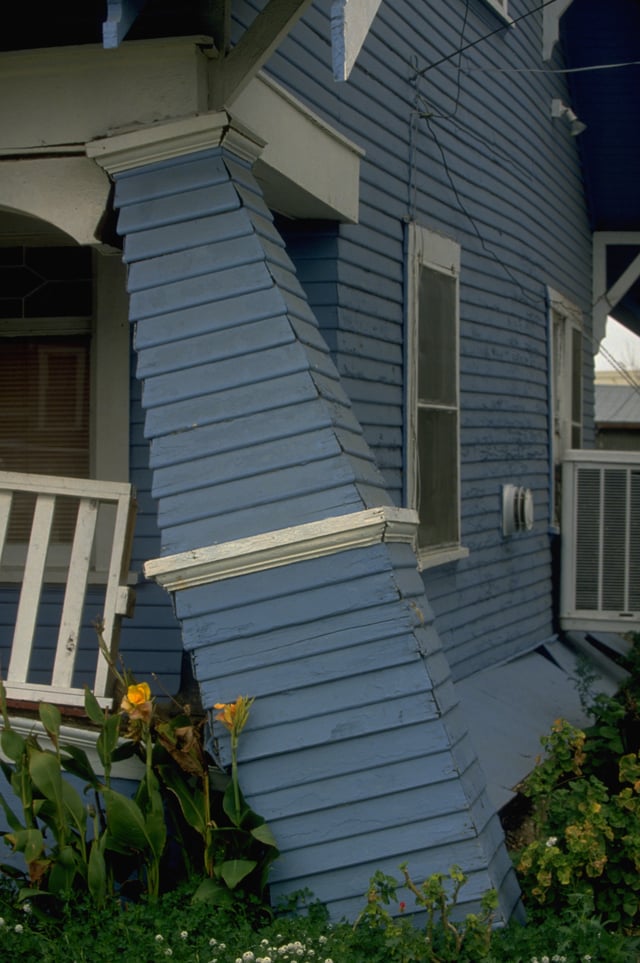
Residential damage in Santa Monica
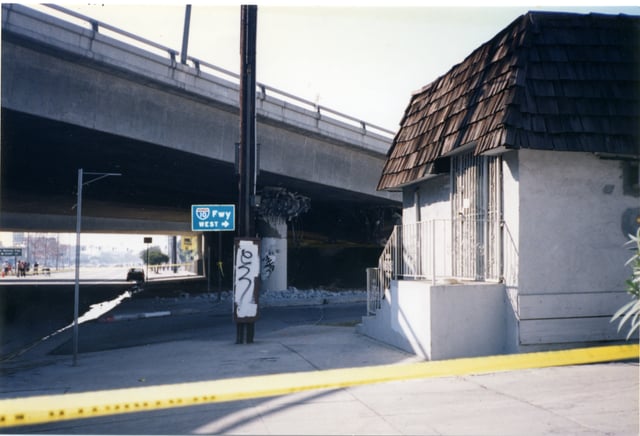
Crushed column (center) along section of Interstate 10 that collapsed
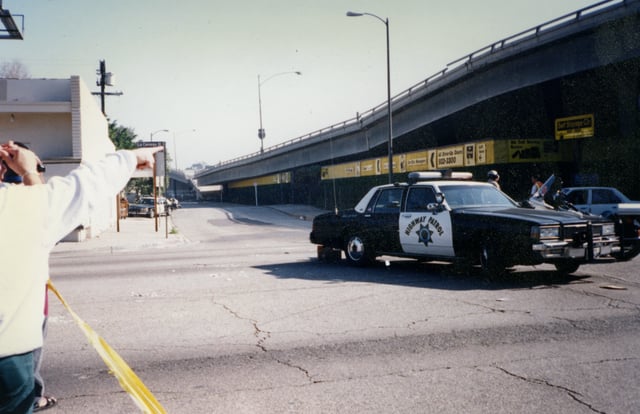
Collapsed section (left of police car) and sag leading to it

Kaiser Permanente building
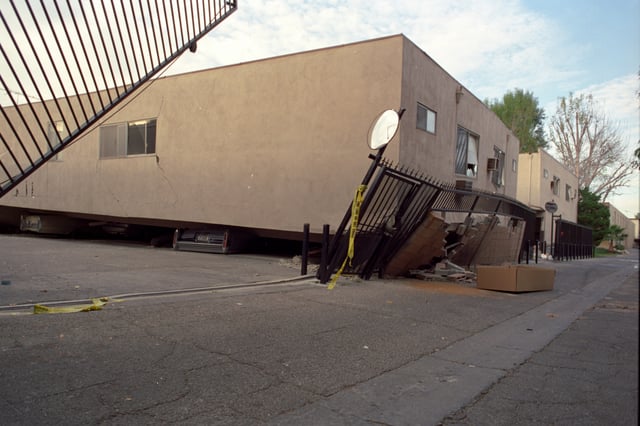
Apartment building that collapsed onto its own footprint, crushing cars parked beneath it
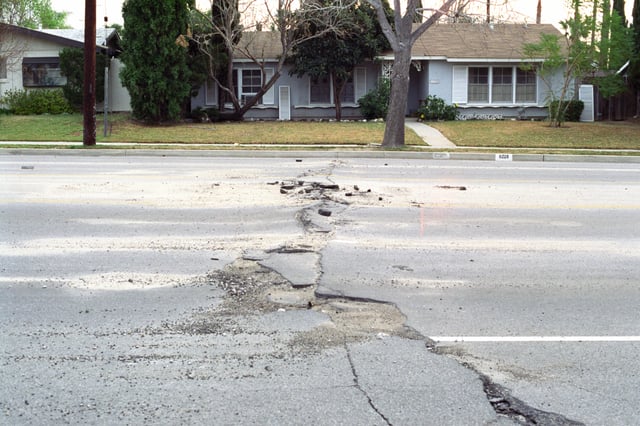
Buckled pavement
Damage occurred up to 85 miles (125 km) away, with the most damage in the west San Fernando Valley, and the cities of Santa Monica, Simi Valley and Santa Clarita. The exact number of fatalities is unknown, with sources estimating it at 60[1] or "over 60",[15] to 72,[16] where most estimates fall around 60.[17] The "official" death toll was placed at 57;[16] 33 people died immediately or within a few days from injuries sustained,[18] and many died from indirect causes, such as stress-induced cardiac events.[19][20] Some counts factor in related events such as a man's suicide possibly inspired by the loss of his business in the disaster.[16] More than 8,700 were injured including 1,600 who required hospitalization.[21]
The Northridge Meadows apartment complex was one of the well-known affected areas in which sixteen people were killed as a result of the building's collapse. The Northridge Fashion Center and California State University, Northridge also sustained very heavy damage – most notably the collapse of parking structures. The earthquake also gained worldwide attention because of damage to the vast freeway network, which serves millions of commuters every day. The most notable was to the Santa Monica Freeway, Interstate 10, known as the busiest freeway in the United States, congesting nearby surface roads for three months while the freeway was repaired. Farther north, the Newhall Pass interchange of Interstate 5 (the Golden State Freeway) and State Route 14 (the Antelope Valley Freeway) collapsed as it had 23 years earlier in the 1971 Sylmar earthquake, even though it had been rebuilt with minor improvements to the structural components.[22] One life was lost in the Newhall Pass interchange collapse: LAPD motorcycle officer Clarence Wayne Dean fell 40 feet from the damaged connector from southbound 14 to southbound I-5 along with his motorcycle. Because of the early morning darkness, he likely did not realize that the elevated roadway below him had collapsed, and was unable to stop in time to miss the fall and died instantly. When the interchange was rebuilt again one year later, it was renamed the Clarence Wayne Dean Memorial Interchange in his honor.
Additional damage occurred about 50 miles (80 km) southeast in Anaheim as the scoreboard at Anaheim Stadium collapsed onto several hundred seats.[23] The stadium was vacant at the time. Although several commercial buildings also collapsed, loss of life was minimized because of the early morning hour of the quake, and because it also occurred on a federal holiday (Martin Luther King Jr. Day). Also, because of known seismic activity in California, area building codes dictate that buildings incorporate structural design intended to withstand earthquakes. However, the damage caused revealed that some structural specifications did not perform as intended. Because of these revelations, building codes were revised. Some structures were not red-tagged until months later because the damage was not immediately evident.
The quake produced unusually strong ground accelerations in the range of 1.0 g. Damage was also caused by fire and landslides. The Northridge earthquake was notable for hitting almost the same exact area as the Mw 6.6 San Fernando (Sylmar) earthquake. Estimates of total damage range between $13 and $40 billion.[24]
Most casualties and damage occurred in multi-story wood frame buildings (e.g. the three-story Northridge Meadows apartment building). In particular, buildings with an unstable first floor (such as those with parking areas on the bottom) performed poorly. Numerous fires were also caused by broken gas lines from houses shifting off their foundations or unsecured water heaters tumbling.[25] In the San Fernando Valley, several underground gas and water lines were severed, resulting in some streets experiencing simultaneous fires and floods. Damage to the system resulted in water pressure dropping to zero in some areas; this predictably affected success in fighting subsequent fires. Five days later, it was estimated that between 40,000 and 60,000 customers were still without public water service.[26] As expected, unreinforced masonry buildings and houses on steep slopes suffered damage. However, school buildings (K-12), which are required by California law to be reinforced, in general, survived fairly well.
Valley fever outbreak
An unusual effect of the Northridge earthquake was an outbreak of coccidioidomycosis (Valley fever) in Ventura County. This respiratory disease is caused by inhaling airborne spores of the fungus. The 203 cases reported, of which three resulted in fatalities, constituted roughly 10 times the normal rate in the initial eight weeks. This was the first report of such an outbreak following an earthquake, and it is believed that the spores were carried in large clouds of dust created by seismically triggered landslides. Most of the cases occurred immediately downwind of the landslides.[27]
Facilities and infrastructure affected
Hospitals
Eleven hospitals suffered structural damage and were damaged or rendered unusable.[21] Not only were they unable to serve their local neighborhoods, but they also had to transfer out their inpatient populations, which further increased the burden on nearby hospitals that were still operational. As a result, the state legislature passed a law requiring all hospitals in California to ensure that their acute care units and emergency rooms would be in earthquake-resistant buildings by January 1, 2005. Most were unable to meet this deadline and only managed to achieve compliance in 2008 or 2009.[28]
Television, movie, and music productions
The production of movies and TV shows was disrupted. At the time of the quake, before dawn on Monday morning, the Warner Brothers film Murder in the First (with Christian Slater, Kevin Bacon, and Gary Oldman) was actually being filmed only four miles from the epicenter. Production, of course, came to a halt. The main courtroom set was in shambles. The building containing the set was later "red tagged" as unsafe due to the damage it sustained. The Star Trek: Deep Space Nine episode "Profit and Loss" was being filmed at the time, and actors Armin Shimerman and Edward Wiley left the Paramount Pictures lot in full Ferengi and Cardassian makeup, respectively.[29] The season five episode of Seinfeld entitled "The Pie" was due to begin shooting on January 17 before stage sets were damaged. NBC's The Tonight Show, hosted by Jay Leno, took place in the NBC Studios in Burbank, close to the epicenter of the quake. Also, ABC's General Hospital, which shoots in Los Angeles, was heavily affected. The set, which is at ABC Television Center, suffered major damage, including partial structural collapse and water damage.
All of the earthquake sequences in the Wes Craven film New Nightmare were filmed a month prior to the Northridge quake. The real quake struck only weeks before filming was completed. Subsequently, a team was sent out to film footage of the quake-damaged areas of the city. The cast and crew had initially thought that the scenes that were filmed before the real quake struck were a bit overdone, but upon viewing the footage after the earthquake, they were reportedly startled by the realism of it.[30]
Some archives of film and entertainment programming were also affected. For example, the original 35 mm master films for the 1960s sitcom My Living Doll were destroyed.[31]
The first and second episodes of the fifth season of Baywatch featured the earthquake, and how the lifeguards responded to it, professionally and personally.
The Animaniacs segment "A Quake! A Quake!" tells the story of the event.
Transportation

Complete failure of Golden State Freeway at Gavin Canyon
Portions of a number of major roads and freeways, including Interstate 10 over La Cienega Boulevard, and the interchanges of Interstate 5 with California State Route 14, 118, and Interstate 210, were closed because of structural failure or collapse.[32] [33]James E. Roberts was chief bridge engineer with Caltrans and was placed in charge of the seismic retrofit program for Caltrans until his death in 2006.
Rail service was briefly interrupted, with full Amtrak and expanded Metrolink service resuming in stages in the days after the quake. Interruptions to road transport caused Metrolink to experiment with service to Camarillo in February and Oxnard in April,[34][35] which continues today as the Ventura County Line, and extended the Antelope Valley Line almost ten years ahead of schedule. Six new stations opened in six weeks.[36] Metrolink leased equipment from Amtrak, San Francisco's Caltrain and Toronto, Canada's GO Transit to handle the sudden onslaught of passengers. Amtrak ceased service in the Pasadena Subdivision following structural damage to a rail bridge in Arcadia and redirected all rail traffic through Riverside and Fullerton. All MTA bus lines operated service with detours and delays on the day of the quake. Los Angeles International Airport and other airports in the area were also shut down as a 2-hour precaution, including Burbank-Glendale-Pasadena Airport (now Hollywood Burbank Airport) and Van Nuys Airport, which is near the epicenter, where the control tower suffered from radar failure and panel collapse. The airport was reopened in stages after the quake.
California State University, Northridge
California State University, Northridge, was the closest university to the epicenter. Many campus buildings were heavily damaged [62] and a parking structure collapsed [63] . Many classes were moved to temporary structures.[37] The 1994 Northridge earthquake greatly affected the CSUN campus, damaging much of its infrastructure, and causing multiple fires and explosions throughout the campus.[38] The 6.7 magnitude earthquake damaged several buildings as well as destroying all communications, such as telephone lines and causing computer systems to shut down. The seismic event killed two CSUN students at the Northridge Meadows Complex along with 14 other residents.[39] The damage caused a shutdown of the campus and delayed the start of the 1994 Spring semester.
Campus damage
All 58 buildings on campus sustained significant damage, resulting in a $406 million recovery effort (equivalent to $690 million today).[40] In addition, the newly completed student parking structure C collapsed, and had to be demolished. The Oviatt Library experienced both interior and exterior damage, but the overall frame of the central part of the building remained stable, allowing student use to continue.[41] In the Science Complex, Building #1 and #2 suffered fire damage while the bridges connecting buildings #3 #4 were closed and named unstable.[42] The Fine Arts Building and the South Library experienced internal structural damage, resulting in the demolition and replacement of both buildings.
Classes and enrollment
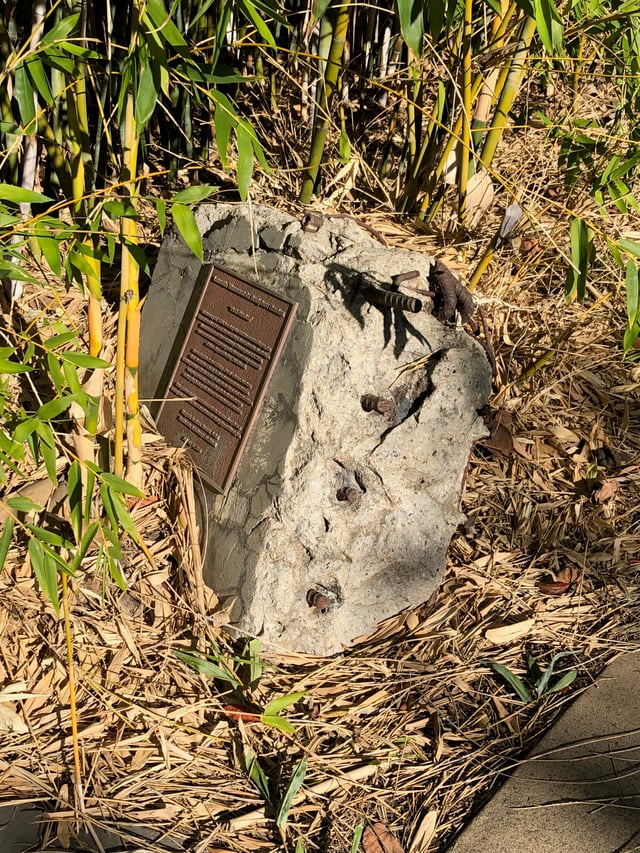
"An earthquake is the shifting of land, a force of nature that affects the natural, built and economic landscape"-Lauretta Wasserstein Sculpture Garden
The 1994 Spring semester was delayed by two weeks due to the Northridge earthquake. The campus was unable to use any of its classrooms because of the damage the buildings sustained. The campus still opened and provided students with mobile classrooms and mobile offices. CSUN President Dr. Blenda Wilson assured the rental of temporary structures to be placed in available spaces throughout the campus. An estimated $350 million (equivalent to $590 million today) was used to supply the number of trailers and domes which housed classes and administration offices. Enrollment dropped by approximately 1,000 students, leaving some homeless as dormitories were closed due to damage which rendered them unsafe and which required repair.[43]
External resources
The seismic event led to millions of dollars worth damage resulting in a sharp drop in student enrollment. Fortunately, CSUN received financial assistance for its efforts in reestablishing the damaged buildings with monetary gifts from the McCarthy Foundation, the Common Wealth Fund, and the Union Bank Foundation. In addition, the campus received a $23,000 check (equivalent to $39,000 today) from the Los Angeles Times Valley Edition for the journalism department.[44] CSUN also received assistance from government agencies FEMA and OES to support the recovery effort and serve the needs of the local community.[45] UCLA and Pierce College opened their doors and allowed CSUN students to use their libraries while providing shuttle buses to and from the university.
Entertainment and sports
Universal Studios Hollywood shut down the Earthquake attraction, based on the 1974 motion picture blockbuster, Earthquake. It was closed for the second time since the Loma Prieta earthquake. Angel Stadium of Anaheim (then known as Anaheim Stadium) suffered some damage when the scoreboard fell into the seats.[23] The theme parks Disneyland, Knott's Berry Farm and Six Flags Magic Mountain were shut down after the quake, but only for inspections since all were designed with earthquakes in mind. The Los Angeles Memorial Coliseum and now-gone Los Angeles Memorial Sports Arena suffered minor damage. The major Hollywood film studios including Warner Bros., 20th Century Fox, Columbia Pictures, Paramount Pictures, Walt Disney Studios and Universal Studios were also shut down. The recording venues Capitol Records and Warner Bros. Records were shut down at the time of the quake. British musicians Paul Hardcastle and Simon Harris narrowly escaped injury and were among guests evacuated when the Sheraton-Universal Hotel in Universal City, California where they were staying was damaged during the earthquake.
The Los Angeles Clippers of the NBA had three home games postponed or moved to other venues. The game scheduled against the Sacramento Kings was postponed, the game against the Cleveland Cavaliers was relocated to The Forum (then the home arena of the Los Angeles Lakers), and the game against the New York Knicks was moved to the Arrowhead Pond (now Honda Center) in Anaheim.
Other buildings
Numerous Los Angeles museums, including the Art Deco Building in Hollywood, were closed, as were numerous city shopping malls. Gazzarri's nightclub suffered irreparable damage and had to be torn down. The city of Santa Monica suffered significant damage. Many multifamily apartment buildings in Santa Monica were yellow-tagged and red-tagged. Especially hard hit was the area between Santa Monica Canyon and Saint John's Hospital, a linear corridor that suffered a significant amount of property damage. The City of Santa Monica provided assistance to landlords dealing with repairs so tenants could return home as soon as possible. In Valencia, the California Institute of the Arts experienced heavy damage, with classes relocated to a nearby Lockheed test facility for the remainder of 1994. The Los Angeles Unified School District closed local schools throughout the area, which reopened one week later. UCLA and other local universities were also shut down. The University of Southern California suffered some structural damage to several older campus buildings, but classes were conducted as scheduled.
Radio and television
Los Angeles' radio and television stations were knocked off the air, but resumed coverage later.
NBC affiliate KNBC was the first television station to go on the air[46] while reporters and anchors Kent Shocknek, Colleen Williams, Chuck Henry, and Joe Rico were producing special reports throughout the morning. Other stations KTLA, KCAL, KCBS and KABC were also off the air. Afterward, anchors and reporters Stan Chambers and Hal Fishman of KTLA, Laura Diaz and Harold Greene of KABC, John Beard of KTTV, and Tritia Toyota of KCBS were doing coverage throughout the day.
Radio stations such as KFI, KFWB and KNX were on the air during the main tremor, causing severe static on the airwaves. KROQ-FM's Kevin and Bean morning show asked those people tuned in to stay out of their homes. Mark & Brian's morning show on KLOS was also affected. The duo spoke to Los Angeles-area residents about their situation.
FM radio stations such as KRTH, KIIS-FM, KOST-FM and KCBS-FM were bringing special reports when morning show hosts Robert W. Morgan, Rick Dees and Charlie Tuna were calling Los Angeles residents and others from their sister stations to bring their belongings to the stations and advising people not to drink water.
Government and organizations
The United States Postal Service suspended all mail service throughout the Los Angeles area for several days. The Los Angeles Public Library shut down most of its branches; books were knocked down during the quake. The Los Angeles City Hall suffered no damage. Los Angeles Mayor Richard Riordan declared a state of emergency and issued curfews in the area, while Governor Pete Wilson and President Bill Clinton visited Los Angeles to tour the area. The Archdiocese of Los Angeles's Cathedral of St. Vibiana suffered severe damage and canceled activities until a new cathedral was built in 2002. The Church on the Way, which is near the epicenter, suffered some damage to the church campus building. The Martin Luther King Jr. Parade, scheduled to take place on January 17, was not held.
Aftermath
Lifestyle disruptions in the weeks following
In the weeks following the quake, many San Fernando Valley residents had either lost their homes entirely or experienced structural damage too severe to continue living in them without making repairs. Although the vast majority of homes in the area, with the exception of a few particular neighborhoods, were relatively unaffected; many feared an aftershock to rival or exceed the severity of the first one. While a notable aftershock never came, many residents opted to stay in shelters or live with friends and family outside the area for a short time following.[47]
While many businesses remained closed in the days following the quake, some infrastructure was not able to be rebuilt for months, even years later. The daily commute for many drivers in the weeks following was significantly lengthened, notably for those traveling between Santa Clarita and Los Angeles, and commuters on I-10 traveling to and from the Westside. Additionally, many businesses were forced to relocate or use temporary facilities in order to accommodate structural damage to their original locations or the difficulty accessing them. Some people even made temporary relocations closer to their jobs while their homes or neighborhoods were being rebuilt.
State legislative response
The Northridge earthquake led to a number of legislative changes. Due to the large amount lost by insurance companies, most insurance companies either stopped offering or severely restricted earthquake insurance in California. In response, the California Legislature created the California Earthquake Authority (CEA), which is a publicly managed but privately funded organization that offers minimal coverage.[48] A substantial effort was also made to reinforce freeway bridges against seismic shaking, and a law requiring water heaters to be properly strapped was passed in 1995.
Building code updates
With each major earthquake comes a new understanding of the way in which buildings respond to them. Advances in the technology associated with testing systems, design and seismic modeling software, structural connections, structural forms, and seismic force resisting systems have accelerated dramatically since Northridge. There is an array of building forms and systems that are no longer legal to build. An example is the previously popular "soft-story" multifamily apartments. These buildings typically look like a three-story box on a narrow lot, where the upper two floors overhang the lower floor and are supported on pipe columns so cars can be parked underneath. Because the ground level is soft relative to the upper floors, the upper portion can sway and fall onto the carport below. Today, no wood floors are allowed to extend more than an additional 15% beyond the shear wall or other lateral-load resisting elements of the floor below. This typically results in overhangs not exceeding three or four feet (90 or 120 cm), compared to the 20 to 40 feet (6–12 m) that were previously built. If an architect still wants this type of design, the structural engineer may specify that the previously used pipe column design be replaced with laterally stiff steel "moment frame". This can also mitigate the problem of the soft-story structure by stiffening the soft ground floor.
See also
1999 Hector Mine earthquake
2019 Ridgecrest earthquakes
List of earthquakes in California
List of earthquakes in the United States
